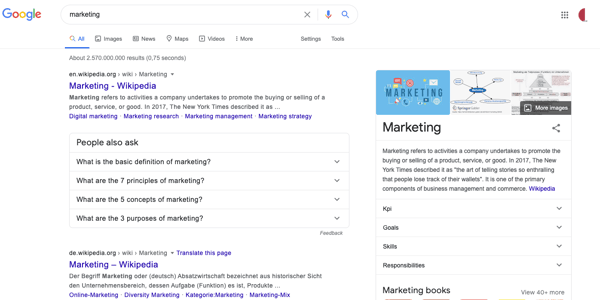The user experience is becoming more and more important! For many years now, it has been clear that the user experience on a website is crucial for the customer journey's success. In the future, however, it will also be increasingly important for finding the website in popular search engines. True to the motto: the customer or user is king! If you want to be at the top of the rankings in 2021, you have to focus on the user!
Google's Page Experience Update
Google announced it early enough - the Page Experience Update is just around the corner and strongly influences many pages' ranking. From May 2021, the loading times of websites will now also be among the official ranking factors.
Furthermore, pages that do well in Core Web Vitals will be highlighted in the SERPs (Search Engine Result Page) in the future.
What are Core Web Vitals?
They represent the new benchmark from Google.
Core Web Vitals include:
- Largest Contentful Paint (LCP): this value indicates the load time of the largest element to load on the web page. Google rates a load time of less than 2.5 seconds as "Good."
- First Input Delay (FID): The decisive factor here is how long the server needs to react to the user's first interaction. Google rates less than 0.1 seconds as "Good" here.
- Cumulative Layout Shift (CLS): This value is about the asynchronous loading of various page elements and the user's associated visual stability. The search engine measures here how often already visible elements are subsequently shifted. A value of less than 0.1 is considered good.
Anyone who still has some catching up to do here and wants to maintain or improve their website's ranking still has time to act until May 2021. In addition to these innovations, other user signals remain important for SEO:
- Time on Page: This value allows conclusions to be drawn about the page content's quality. It measures how long the user stays on a page.
- Bounce rate: The bounce rate indicates the percentage of users who leave the website without interacting. Therefore, it is also a significant value that indicates the quality of the page content. Appealing and well-placed CTAs (call-to-action) are a real game-changer here.
- Click-through rate (CTR): This measures the number of clicks on a search result or ad.
The E-A-T principle - expertise, authority, and trustworthiness
What is the user's intention in his search? - Does he want to obtain information on a topic, does he want to take an action such as making a purchase, or is he specifically looking for a particular website? Optimizing websites with these three search intentions in mind also influences the ranking of search results. Google Search Quality Raters evaluate websites according to search intentions and incorporate their results into the search algorithm. Therefore, it is crucial always to keep the user in mind when creating or optimizing a website. Especially websites with YMYL content ("Your Money or Your Life"), i.e., content that influences the user's quality of life, should deal with the E-A-T principle. This type of content includes, for example, websites in the fields of finance, health, or law. If sites in these industries do not demonstrate expertise, authority, or trust, the ranking will be poor.
Zero Click Searches
Zero Click Searches or No Click Searches are search queries that do not result in a user click on an external page indexed by Google. In this case, the user's search is already completed when the Google search results page appears.
One question - immediate answer, no more click necessary: 
Websites that want to appear in the snippets must pay particular attention to SEO and high-quality content. If you want your site to be seen in the information snippets, called "Fraggle" (term: "Fragment" & "Handle"), you have to rely on pointed content that is tailored to the users' search intentions. For example, FAQ pages are a great way to provide users with quick and easy answers. Simple topics are increasingly dealt with directly in the search results. Complex and more in-depth topics, on the other hand, tend to generate clicks. Here, however, it is also crucial to pay attention to SEO to generate traffic. Ultimately, the bottom line is to offer search engine optimized content for different search intentions to get noticed by users.
"Predictive Search" - optimize ahead of time.
Google always tries to adapt its search results according to user behavior. Artificial intelligence (AI) helps to provide users with a "Predictive Search." To do this, it analyzes user data and makes predictions about what users might be interested in. Google's algorithms thus examine the quality of content and the interest of users. Therefore, it is essential that page content is optimally tailored to the relevant target group and always up-to-date.
Read more about SEO (search engine optimization) in our whitepaper:










